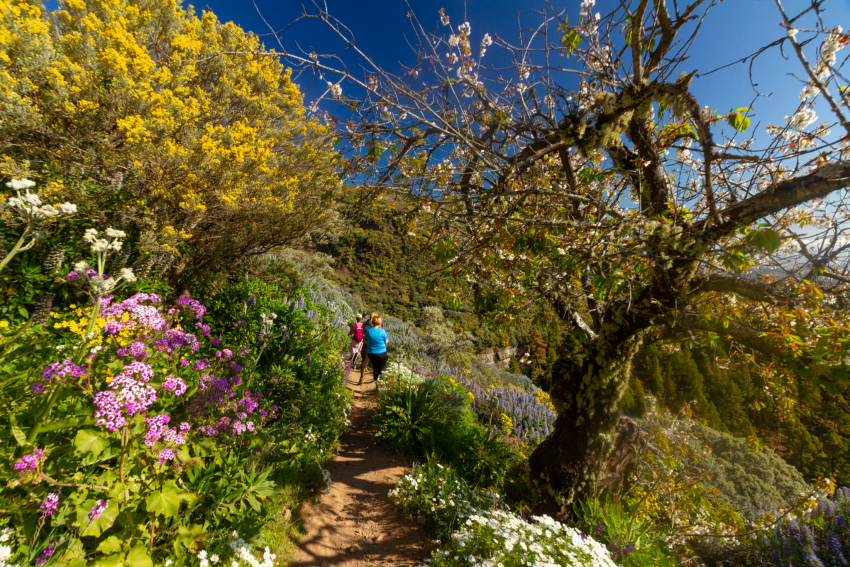-
Home

-
Info

-
Sports & Activities

-
Walking

- tenteniguada
The Tajinaste Trail: Gran Canaria's Most Spectacular Spring Walk
Between March and the end of April the chunk of Gran Canaria between the Caldera de los Marteles and Tenteniguada, high up in the hills above Telde, goes technicolour.
This spring explosion of colour comes from a range of native species with purple, blue, yellow and red flowers. The most famous are the tajinastes or viper's bugloss flowers but buttercups, aeoniums, cinerarias, poppies and sonchus (giant dandelions ) all flower here at the same time.
Most of the tajinastes are blue, pink or purple but the challenge is to spot one of the rare red flowered plants.
You can walk a long loop from the Caldera de los Marteles down to Tenteniguada (about 6km) and back up again but the bulk flowers are within a kilometre of the road just past the clump of pine trees. There is no bus back up so you either walk or use the old two-car trick. Bring food and water as there is nothing up here once you start walking (there is a snack van by the mirador).
To reach the Caldera, put the Caldera de los Marteles viewpoint into Google Maps and drive up through Telde and Lomo Magullo. Some Bus 13s also stops here on route from Telde to Tenteniguada but not all. If you get the bus to Los Marteles, you can walk back down to Tenteniguada and get another bus back to Telde and then on to Las Palmas or the resorts. To be honest, it is quicker and easier to do this with a hire car.
The flowers are down the hill on the side of the road opposite the crater. Just walk down the wide path until your eyes hurt and you are right there amongst Gran Canaria's most spectacular spring display.
Gran Canaria Info recommends:
- Default
- Title
- Date
- Random
Join the Gran Canaria Info newsletter list
Gran Canaria info recommends
-

Off The Beaten Track With A Gran Canaria Buggy Trip
-

Casa Romantica: A Classic Gran Canaria Restaurant Reborn
-

Which Gran Canaria Airport Transfer Service Is The Best?
-

Hassle-Free Gran Canaria Car Hire
-

The Best Value Car Rental Service In Gran Canaria
-

Gran Canaria Shopping: Start At Fundgrube For Price & Quality
- 1
Follow us on Facebook
Tip of the day
-
The Best Gran Canaria Weather Forecast

The single most common question we get in the Gran Canaria Info group is...
What is the weather going to be like during my holiday?
The answer is almost always the same: If you are going to south Gran Canaria's resorts, it is very likely to be sunny every day. Yes, even in the winter. Yes, even though your weather app says it is going to be cloudy. Yes, even in January. And in February, etc.
Obviously it does sometimes rain in Gran Canaria, even in the sun-baked south, and there are occassional cloudy days.
To check for these rare rain and clouds there is no point using generic weather apps because they use data that averages out the weather and temperature across Gran Canaria.
This means that the forecast for Puerto Rico and other resorts includes weather and temperatrure predictions for inland and highland areas that are cooler and cloudier.
So, instead of believing your current weather app use the Spanish weather service website called the AEMET. It's website has detailed and very accurate forecasts for individual resorts, town and even beaches.
Here's the forecast for the Mogán area including Puerto Rico.
The mobile website works very well in English although the app is only in Spanish at the moment.
Latest articles
Who's Online
We have 4042 guests and no members online





